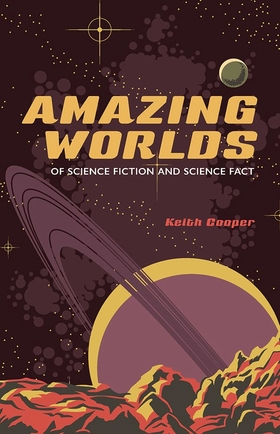Centauri Dreams
Imagining and Planning Interstellar Exploration
Cometary Origins
We’ve learned a great deal about comet 67P Churyumov-Gerasimenko thanks to the European Space Agency’s Rosetta mission. What stands out to me is the fact that 40 percent of the comet, in terms of mass, is made up of organic compounds — combinations of hydrogen, carbon, oxygen and nitrogen. These ‘building blocks’ of life on Earth are readily available and could have been delivered over and over again through our planet’s long impact history.
But where did the organic compounds themselves come from? Jean-Loup Bertaux (CNRS / UPMC / Université de Versailles Saint-Quentin-en-Yvelines), working with Rosine Lallement (Observatoire de Paris / CNRS / Université Paris Diderot), has put forth the idea that the organics formed in interstellar space long before the formation of the Solar System.
The idea no longer seems as startling as it once might have, thanks to our continuing study of what are called diffuse interstellar bands, or DIBs. Revealed by spectroscopic studies, these are absorptions at specific wavelengths that turn up in the spectra of various astronomical objects, caused by the absorption of light in the interstellar medium. DIBs began to be recorded in the early 1900s, with over 100 of them being identified from the ultraviolet through the near infrared.
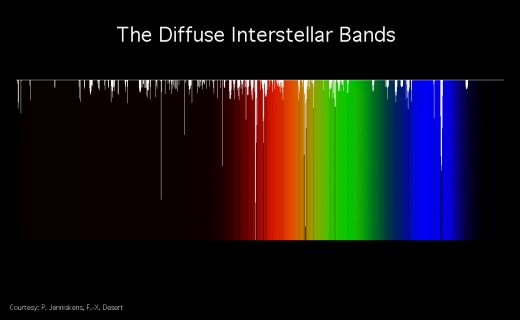
Image: Relative strengths of known diffuse interstellar bands. Credit: NASA/ Peter Jenniskens.
Diffuse interstellar bands appear to show organic material, found in most cases in roughly the same proportions wherever they are observed. In dense clouds of matter like those that will spawn stars, however, DIB absorption drops.
The mechanism? Bertaux and Lallement believe the organic molecules that produce DIBs clump together in such dense environments, and the clumped matter absorbs less radiation than the free-floating matter. “The decrease of DIB during line-of-sight crossings of the dense cores of interstellar clouds,” the authors write, “and the simultaneous steepening of the Far UV part of the reddening curve suggest that DIB carriers coagulate and are constituent of the very small grains eventually preserved in comets.”
In other words, organic molecules from the interstellar medium would have been conserved as the early nebula around growing young stars like the Sun coalesced, and would gradually have been incorporated into cometary nuclei, as comets like 67P/CG formed through the gradual accretion of grains of growing size. The authors also note that the ratio of organics could be increased by other organic molecules in the interstellar medium that do not show up in DIBs.
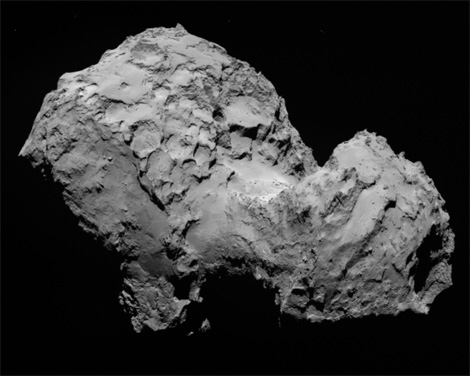
Image: The nucleus of comet 67P Churyumov-Gerasimenko (“Chury”) as seen by the European Rosetta space probe. Credit: ESA / Rosetta / MPS for OSIRIS Team MPS/UPD/LAM/IAA/SSO/INTA/UPM/DASP/IDA.
We’re dealing with pristine material, for the organics would have remained in the comets ever since their formation 4.6 billion years ago. The prospect for future missions is that we should be able to fetch a sample of these materials that could help us understand their true identity. If they are interstellar in origin, then the same materials should have been delivered to many systems. Thus the dust of comet 67P Churyumov-Gerasimenko gives us clues to an interstellar absorption feature that could mark the spread of organic compounds throughout the galaxy.
The paper is Bertaux & Lallement, “Diffuse Interstellar Bands carriers and cometary organic material,” published by Monthly Notices of the Royal Astronomical Society 31 August 2017 (abstract).

Juno: Auroral Activity on Jupiter Up Close
While we track hurricane Irma and its path of devastation in the Caribbean, another kind of storm is affecting the skies over more northerly areas. A strong geomagnetic storm watch continues in effect, making it possible that the aurora borealis — northern lights — will be visible further south than usual, in Scotland and southern Scandinavia but perhaps into the continental United States as well, while the aurora australis could be active for those in the more southerly latitudes below the equator. All of this is due to sunspot AR2673, which is the source of a flare and coronal mass ejection hurled out of the Sun on Monday.
I’ve seen the northern lights in Iceland on one spectacular October night, but only once — in Iowa, in 1970 — have I seen them in the US. The phenomenon results from electrons accelerated as they encounter the Earth’s magnetosphere, following the magnetic field lines to the polar regions, where from 500 kilometers down to 80 kilometers up, they collide with oxygen and nitrogen in the atmosphere. People have described the resulting effect as a rippling curtain, sometimes white, sometimes in shifting colors, which is what I saw in Iceland.
The segue here is to the Juno spacecraft, which is giving us data about the powerful energies swirling around Jupiter’s polar regions, contributing to that planet’s own auroral patterns. Juno made its seventh science flyby on September 1 at 21:49 UTC, with perijove (the point in its orbit when it is closest to the center of the planet) at about 3500 kilometers above the cloud tops.
Juno’s ultraviolet spectrograph and energetic-particle detector instruments are showing us how powerful electrical potentials aligned with the planet’s magnetic field are accelerating electrons into the atmosphere at energies of up to 400,000 volts. This turns out to be 10 to 30 times higher than the largest auroral potentials we’ve ever observed in Earth’s auroras.
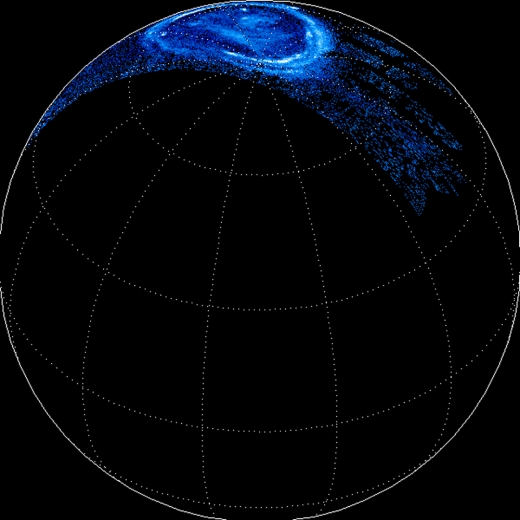
Image: This is a reconstructed view of Jupiter’s northern lights through the filters of Juno’s ultraviolet imaging spectrometer (UVS) instrument on Dec. 11, 2016, as the Juno spacecraft approached Jupiter, passed over its poles, and plunged towards the equator. Such measurements present a real challenge for the spacecraft’s science instruments: Juno flies over Jupiter’s poles at 50 kilometers per second, speeding past auroral forms in a matter of seconds. Credit: NASA/JPL-Caltech/SwRI.
Given that Jupiter was already known to generate the most spectacular auroras in the Solar System, this comes as no surprise. What does raise the eyebrows is that despite the size of these electrical potentials, they do not appear to be the source of the most intense auroras, as they are at the Earth. Barry Mauk (Johns Hopkins University Applied Physics Laboratory) leads the team handling the spacecraft’s Jupiter energetic particle detector Instrument:
“At Jupiter, the brightest auroras are caused by some kind of turbulent acceleration process that we do not understand very well,” said Mauk. “There are hints in our latest data indicating that as the power density of the auroral generation becomes stronger and stronger, the process becomes unstable and a new acceleration process takes over. But we’ll have to keep looking at the data.”
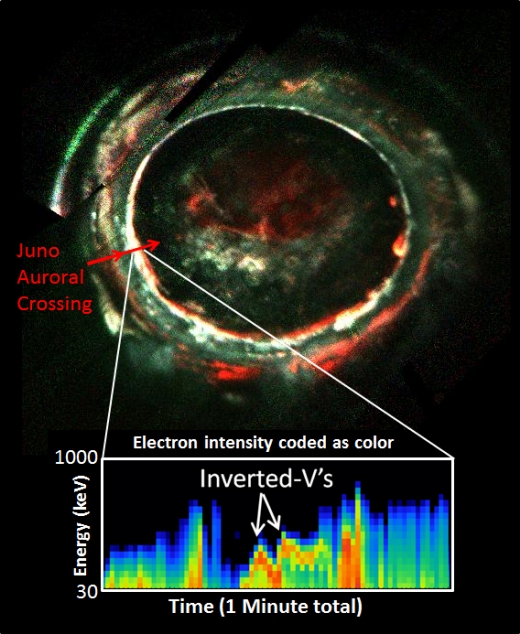
Image: This image, created with data from Juno’s ultraviolet imaging spectrometer, marks the path of Juno’s readings of Jupiter’s auroras, highlighting the electron measurements that show the discovery of the so-called discrete auroral acceleration processes indicated by the “inverted Vs” in the lower panel. This signature points to powerful magnetic-field-aligned electric potentials that accelerate electrons toward the atmosphere to energies that are far greater than what drive the most intense aurora at Earth. Scientists are looking into why the same processes are not the main factor in Jupiter’s most powerful auroras. Credit: NASA/JPL-Caltech/SwRI.
We can take advantage of the extreme conditions at Jupiter to study what happens when charged particles are accelerated to the immense energies on display in Juno’s data, which gives us insights into how distant astrophysical systems operate. But understanding Jupiter’s radiation belts is likewise a key challenge for the near-term, because spacecraft operating in the vicinity of the giant planet, as we want to do when we examine its Galilean moons, face the problem of engineering solutions to withstand these radiation levels.
Space weather, in other words, turns out to be valuable for the lessons it provides on protecting instruments and future astronauts in conditions as harsh as these. So if you do see the aurora borealis or australis tonight, or if you did last night, keep in mind that the comparative study of Earth and Jupiter’s magnetosphere seems to be showing new processes at work at the highest energy levels. That’s all to the good for planetary physics and the health of future missions.
The paper is Mauk et al., “Discrete and broadband electron acceleration in Jupiter’s powerful aurora,” Nature 549 (7 September 2017), pp. 66-69 (abstract).

On Gas Giants and TRAPPIST-1
You would think that seven planets around TRAPPIST-1 would be more than enough, but Alan Boss and colleagues at the Carnegie Institution for Science are asking whether this system might not also contain one or more gas giants. It’s a theoretical question given weight by the desire to learn more about planet formation, for if we can find gas giants here, it would give credence to a model of gas giant formation championed by Boss. The team has now put constraints on the mass of any gas giants that might lurk here, a prelude to further study.
The core accretion model is widely accepted as a way to create planets like our Earth. Here, the gas and dust disk surrounding a young star shows slow accretion as small particles begin to clump together, gradually forming into planetesimals and, via collisions and other interactions, eventually assembling planets, along with a great deal of leftover debris.
Core accretion can be modeled and seems to fit what we see in other infant planetary systems, but gas giants continue to raise questions. For a gas giant to form this way, it would have to accrete as a solid core that gradually gained enough mass to attract its dense envelope of surrounding gas. One problem with this is that in the lengthy time required for core accretion, the gaseous disk is also depleted. Unless they form relatively quickly, which core accretion rules out, how would gas giants manage to produce such dense atmospheres?
The theory that Boss has long championed holds that there is a process called disk instability in which the circumstellar disk begins to take on a formation something like the spiral arms of a galaxy. Increasing in mass and density, the largest clumps formed in this way would coalesce — on relatively short timescales — into gas giants. Here’s how he explains disk instability in his 2009 book The Crowded Universe:
Most of the mass contained in gas giant planets is hydrogen and helium gas, with only a minor fraction coming from the iron and silicate rocks that form the bulk of the terrestrial planets. These rocks can take their time in forming a planet such as Earth, but the gas needed for forming gas giant planets is known to disappear from young stars on time scales of a few million years or less. Hence, if a gas giant planet is going to form at all, it must do so before the planet-forming disk’s gas disappears through a combination of being eaten by the voracious young protostar and being blown back out into space by winds and radiation from the protostar or other nearby young stars.
All of that demands a rapid gas giant formation process. TRAPPIST-1 comes into play because it’s a low mass star, some twelve times lower in mass than the Sun. If it can produce a gas giant or two, the onus would be on the core accretion model to explain how the system could have produced it. Boss believes disk instability offers an answer. This is why his team, which includes Proxima Centauri b discoverer Guillem Anglada-Escudé, has made such a close study of TRAPPIST-1, one that may eventually let us make the call on the presence of gas giants.
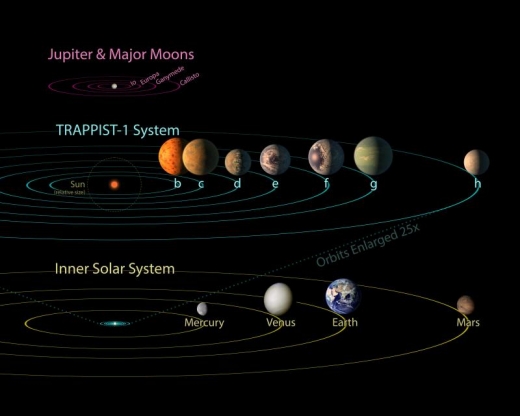
Image: All seven TRAPPIST-1 planets could easily fit inside the orbit of Mercury, our own Solar System’s innermost planet. Alan Boss and his colleagues investigated whether it’s possible that the TRAPPIST-1 system could contain gas giant planets on much longer-period orbits than the seven known terrestrial ones. Credit: NASA/JPL-Caltech.
Boss and colleagues studied the star with astrometric methods, which measure the position of a star in the sky with accuracy great enough to see the slight changes in motion caused by its planets. Astrometry is hard to do, but its rewards are potentially great, as it can provide accurate estimates of a planet’s mass, a value that challenges other planet detection methods. Unlike radial velocity techniques, astrometry works best at planets on long orbital periods, which makes it ideal for trying to locate gas giants like Jupiter in outer system orbits.
The researchers used Carnegie’s CAPSCam astrometric camera, attached to the 2.5-meter du Pont telescope at Las Campanas Observatory (Chile) to determine the upper limits for gas giants at TRAPPIST-1. The result: There are no planets larger than 4.6 times Jupiter’s mass orbiting the star with a period of one year, and no planets larger than 1.6 times Jupiter’s mass orbiting the star with 5 year periods. Given how tightly packed the TRAPPIST-1 planets are, these are wide orbits, and as Boss says, “There is a lot of space for further investigation between the longer-period orbits we studied here and the very short orbits of the seven known TRAPPIST-1 planets.”
If gas giants are eventually discovered at TRAPPIST-1, would this vindicate disk instability in the formation of such worlds? The paper doesn’t go deeply into the matter:
Montet et al. (2014) combined Doppler and direct imaging results to estimate that about 6.5% of M dwarfs host one or more gas giants within 20 AU. Gas giants orbiting M dwarfs may represent a challenge to the core accretion formation mechanism for gas giant planet formation (e.g., Koshimoto et al. 2014), but not for the competing disk instability mechanism (e.g., Boss 2006).
There is work suggesting that core accretion is less likely as a gas giant formation model around M-dwarfs because core accretion operates more slowly in M-dwarf systems, which would mean an outer gas giant is hard to explain without disk instability — core accretion doesn’t give the gas giant enough time to form. Alan Boss was kind enough to go into the problem more fully in an email this morning:
The classic problem for making gas giants by core accretion around low mass stars is that orbital periods are much longer at a given distance for such low mass stars. Core accretion needs many orbital periods to elapse before collisions result in enough growth to form the cores, and when the orbital period is long enough, the collisions cannot proceed fast enough to grow the cores before the disk gas is dissipated by accretion onto the protostars or by disk winds or photoevaporation etc.
All of this would make any gas giants found around TRAPPIST-1 a likely result of disk instability. Further work on the star using astrometric methods is ongoing and should eventually be able to give us a definitive answer. The team is working to improve its techniques “…with the goal of reducing sources of systematic errors, such as those caused by differential chromatic refraction, and by distortions of the entire optical system that might change with time.”
The paper is Boss et al., “Astrometric Constraints on the Masses of Long-Period Gas Giant Planets in the TRAPPIST-1 Planetary System,” Astronomical Journal Vol. 154, No. 3 (23 August 2017). Abstract / preprint.

Red Dwarf UV: Too Little to Spark Life?
We’re going to need a lot more information about the effects of ultraviolet light as we begin assessing the possibility of life on the planets of red dwarf stars. We already know that young red dwarfs in particular can throw flares at UV wavelengths that can damage planetary atmospheres. They can also complicate our search for biosignatures through processes like the photodissociation of water vapor into hydrogen and oxygen, a non-biological source of oxygen of the kind we have to rule out before we can draw even tentative conclusions about life.
Could flares have astrobiological benefits as well? That’s a question that emerges from a new paper from Sukrit Ranjan (Harvard-Smithsonian Center for Astrophysics) and colleagues. What concerns Ranjan’s team is that red dwarf stars may not emit enough ultraviolet to benefit early forms of life. On the primitive Earth, UV may have played a key role in the formation of ribonucleic acid. If this is the case, then UV flare activity could actually help red dwarf planets by compensating for the lower levels of UV red dwarfs produce when they are quiescent.
“We still have a lot of work to do in the laboratory and elsewhere to determine how factors, including UV, play into the question of life,” said co-author Dimitar Sasselov, also of the CfA. “Also, we need to determine whether life can form at much lower UV levels than we experience here on Earth.”

Image: This artist’s impression shows how the surface of a planet orbiting a red dwarf star may appear. The planet is in the habitable zone so liquid water exists. However, low levels of ultraviolet radiation from the star have prevented or severely impeded chemical processes thought to be required for life to emerge. This causes the planet to be devoid of life. M. Weiss/CfA
But back for a moment to the question of UV and the early Earth. As the authors show in their paper, UV can power up prebiotic photochemistry. The literature on this is diverse and includes discussions of UV in relation to the origin of chirality, the synthesis of amino acid precursors and the polymerization of RNA. We can draw some inferences from RNA and DNA themselves, as the paper notes:
Measurements of nucleobase photostability suggest that the biogenic nucleobases (the informational components of the RNA and DNA monomers) are exceptionally stable to UV irradiation compared to structurally similar molecules with comparable thermal properties, suggesting they evolved in a UV-rich environment (Rios & Tor 2013; Beckstead et al. 2016; Pollum et al. 2016). This scenario is consistent with our understanding of conditions on prebiotic Earth: UV light is thought to have been abundant on young Earth due to the absence of a biogenic ozone layer (Cockell 2000a,b; Ranjan & Sasselov 2016).
Recent work by Ranjan and Sasselov has explored the interaction between UV radiation and prebiotic chemistry to the point that the authors now argue such interactions will be an important consideration as we try to understand the surface environment of planets orbiting red dwarfs. If correct, the hypothesis could give us a new criterion for assessing planetary habitability.
These matters are significant because the first atmospheres of planets in their stars’ habitable zones that we will be able to analyze will be found around stars like TRAPPIST-1, LHS 1140 and, of course, Proxima Centauri, the closest red dwarf of all. The figures for UV radiation are striking, with the authors estimating that prebiotic Earth-analog planets would experience between 100 and 1000 times less UV than would have been available on the early Earth.
“It may be a matter of finding the sweet spot,” said co-author Robin Wordsworth of the Harvard School of Engineering and Applied Science. “There needs to be enough ultraviolet light to trigger the formation of life, but not so much that it erodes and removes the planet’s atmosphere.”
If the key question for future laboratory work is whether UV levels this low can support life’s formation, we’re still forced to cope with the fact that we have only one known instance of abiogenesis. And even here on Earth, the question of exactly how life emerged remains the subject of debate. It is not inconceivable that we might find signs of life on a red dwarf planet that emerged along entirely different lines than the life that appeared on our own.
This is interesting stuff, because in most papers treating the question of UV on red dwarf planets, the radiation is considered a negative for habitability. A large amount of work has gone into analyzing whether various mechanisms exist that could protect surface life from UV flares, everything from biofluorescence to ozone layers and oceans. But if we exclude very active young stars, the authors argue, non-flare UV experienced at the surface of habitable zone planets could be clement for life. The question becomes, is it strong enough for life to begin?
The authors’ concern:
…uncertainty over whether the UV-dependent prebiotic pathways that may have led to the origin of life on Earth could function on planets orbiting M-dwarfs, such as the recently-discovered habitable zone planets orbiting Proxima Centauri, LHS 1140, and TRAPPIST-1. Even if the pathways proceed, their reaction rates will likely be orders of magnitude lower than for planets around Sunlike stars, potentially slowing abiogenesis.
Thus the paper calls for laboratory work measuring the reaction rate of UV-dependent prebiotic pathways, and analyzing their susceptibility to changes in radiation level. If we learn that red dwarf planets do not receive sufficient radiation at these wavelengths, then we may want to turn our attention to the more active red dwarfs, whose frequent flares can power photochemistry.
The paper is Ranjan, Wordsworth and Sasselov, “The Surface UV Environment on Planets Orbiting M-Dwarfs: Implications for Prebiotic Chemistry & Need for Experimental Follow-Up,” Astrophysical Journal Vol. 843, No. 11 (10 July 2017). Abstract / preprint.

Water Loss Prospects at TRAPPIST-1
We’re going to eventually get to know the seven planets of the TRAPPIST-1 system well. That’s because they present the ideal targets for upcoming attempts to probe the atmospheres of Earth-sized rocky planets. Orbiting an M-dwarf some 39 light years out, all seven of the planets here transit. Because of the faintness of their star and the size of the planets themselves, they present excellent candidates for transit spectroscopy, in which we look at the light from the star through planetary atmospheres to deduce their constituents.
Using the Space Telescope Imaging Spectrograph on the Hubble instrument, an international team led by Vincent Bourrier (Observatoire de l’Université de Genève) has been studying the ultraviolet radiation received by each of the planets in the system. The more we know about the star’s output, the more we can plug values into the atmospheric escape processes that can occur in its planets, with huge consequences for surface conditions. The team in particular was looking for the signature of an extended atmosphere for TRAPPIST-1 c.
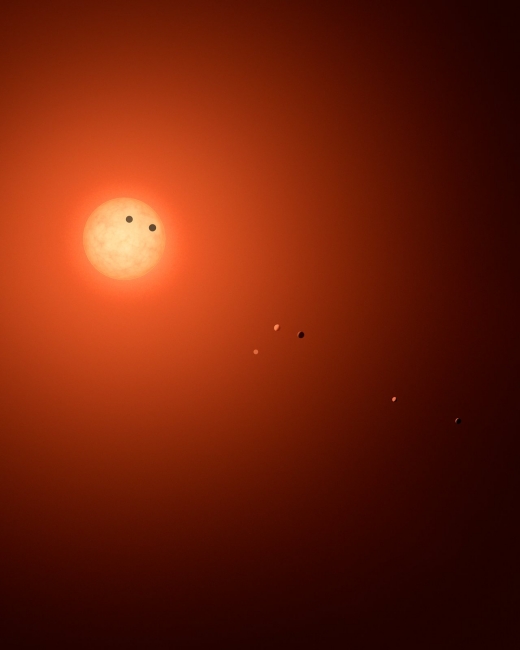
Image: This is an artist’s impression of the TRAPPIST-1 system, showcasing all seven planets in various phases. When a planet transits across the disk of the red dwarf host star, as two of the planets here are shown to do, it creates a dip in the star’s light that can be detected from Earth. During such transits astronomers are able to study the potential atmospheres of these planets. Credit: NASA.
How would such an atmosphere be found? Low-energy ultraviolet radiation can break down water molecules, producing oxygen and hydrogen — the process is known as photo-dissociation. By heating the upper atmosphere, stronger ultraviolet (XUV) radiation as well as X-rays can play a role in letting the hydrogen and oxygen escape into space.
We wind up with hydrogen that can theoretically be detected in the exosphere of the planet, which can be seen as a possible marker for water vapor in the atmosphere. We’ve had hints in earlier transits of planets b and c, also studied by Bourrier, that “could either indicate extended atmospheres of neutral hydrogen or intrinsic stellar variability.” The current work, however, was unable to detect a hydrogen exosphere during a transit of c. We may still be able to find such hydrogen in future observations with the James Webb Space Telescope.
In the absence of such a detection, this paper focuses on the irradiation of the star and the wide range of consequences for water on its planets. We learn that the amount of ultraviolet radiation TRAPPIST-1 is putting out could lead to significant water loss over the history of the system. Based on their measurements, the researchers arrive at an estimate of present XUV radiation and go on to calculate the possible water loss.
This gets interesting because it covers the entire planetary system and describes markedly different rates of water loss. From the paper:
With our current knowledge of the TRAPPIST-1 system, the major uncertainty on the water loss estimates comes from the uncertainty on the planet masses, rather than on the XUV luminosity. Setting the masses to their nominal estimates from Gillon et al. (2017) we found that planets g and closer-in could have lost more than 20 Earth oceans through hydrodynamic escape, if the system is as old as 8 Gyr. Planets b, c, and possibly d could still be in a runaway phase, but if water loss drops down significantly within and beyond the HZ, planets e, f, g, and h might have lost less than 3 Earth oceans.
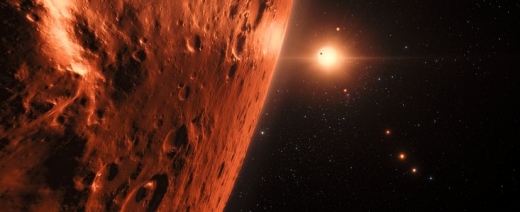
Image: This artist’s impression shows the view from the surface of one of the planets in the TRAPPIST-1 system. At least seven planets orbit this ultracool dwarf star 40 light-years from Earth and they are all roughly the same size as the Earth. Several of the planets are at the right distances from their star for liquid water to exist on the surfaces. Credit: ESO/N. Bartmann / spaceengine.org.
We would expect planets b and c, the two innermost worlds, to have the highest water loss over the eight billion years this system has been in existence, but it’s notable that planets e, f and g — the three thought to be in the habitable zone — could have lost a good deal less. That would imply the possibility that these perhaps temperate worlds still have water on their surfaces.
The authors point out that their estimates of water loss should be considered as upper limits, because their assumptions probably maximize the rate of the XUV interaction with the atmosphere. All planets except TRAPPIST-1 b and c could, they argue, harbor significant amounts of water, perhaps aided by outgassing, depending on planet formation models that include water content. But this is a tough calculation, and it depends on mass:
The amount of water outgassed after a few hundred Myr (after which TRAPPIST-1 h to e, and possibly d, have entered the HZ), is greater for planets with more massive refractory parent bodies. Improving our constraints on the planet masses of the TRAPPIST-1 system will therefore significantly improve our understanding of the variable outgassing capabilities of the TRAPPIST-1 planets and hence the current state of their atmospheres.
Are there other physical mechanisms that could affect the loss of atmospheres and, possibly, their replenishing? Other gases might slow the outflow, while stellar flares could increase it. On flares, however, Bourrier and team note that they observed no flaring activity in their observations at X-ray and far ultraviolet wavelengths, while earlier observations in the optical and infrared have shown a low rate of flares, with weak flares every few days but stronger flares once every two to three months, a rate the authors consider low.
We also have to take into account the possible effects of the stellar wind from TRAPPIST-1, which can likewise erode atmospheres, especially in the earlier phases of the system’s evolution. Our lack of knowledge of possible magnetic fields, which can affect the rate of atmospheric loss, is due to our lack of information about the composition and structure of the planets here. No wonder, then, that Bourrier is careful about his assessment:
“While our results suggest that the outer planets are the best candidates to search for water with the upcoming James Webb Space Telescope, they also highlight the need for theoretical studies and complementary observations at all wavelengths to determine the nature of the TRAPPIST-1 planets and their potential habitability.”
So much depends on JWST, which may be able to nail down our estimates on any hydrogen exospheres in TRAPPIST-1 planets. The paper is Bourrier et al., “Temporal evolution of the high-energy irradiation and water content of TRAPPIST-1 exoplanets,” accepted at the Astronomical Journal (preprint).

New Activity of Repeating FRB 121102
Andrew Siemion, who heads up the Breakthrough Listen initiative and is director of the Berkeley SETI Research Center, sent out a message to astronomers on August 29 noting recent activity from the radio source FRB 121102. The heightened activity had been noted by Breakthrough Listen postdoctoral researcher Vishal Gajjar. You’ll recall that Fast Radio Bursts (FRBs) are powerful but extremely short-duration radio pulses whose sources generally remain unknown.
What tags FRB 121102 as especially interesting is that it is the only FRB known to repeat. In fact, more than 150 bursts have been observed coming from the dwarf galaxy 3 billion light years from Earth that is thought to be its place of origin. And now we have heightened activity in the form of 15 new bursts, as the Astronomer’s Telegram notes:
These are the highest frequency and widest bandwidth detections of bursts from FRB 121102 obtained to-date. Additional fully calibrated full-Stokes analysis employing coherent dedispersion on raw voltage data is ongoing. These observations may indicate FRB 121102 is currently in a heightened activity state [Law et al. arXiv:1705.07553], and follow-on observations are encouraged, particularly at higher radio frequencies.
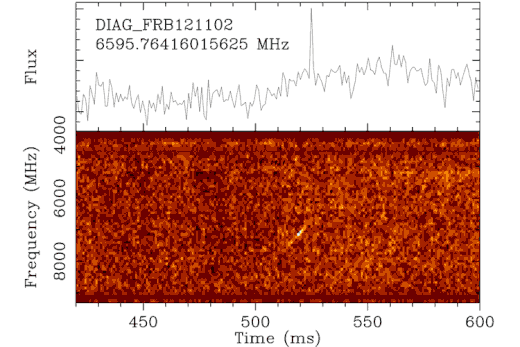
Image: A sequence of 14 of the 15 detected bursts illustrate their dispersed spectrum and extreme variability. The streaks across the colored energy plot are the bursts appearing at different times and different energies because of dispersion caused by 3 billion years of travel through intergalactic space. In the top frequency spectrum, the dispersion has been removed to show the 300 microsecond pulse spike. Capturing this diverse set of bursts was made possible by the broad bandwidth that can be processed by the Breakthrough Listen backend at the Green Bank Telescope. Credit: Breakthrough Listen.
Do FRBs mark the catastrophic end of some kind of astronomical object? If so, the fact that FRB 121102 repeats sets it apart from the rest. A rotating neutron star with an extremely strong magnetic field is also a possibility. There is also a SETI possibility: High-energy laser bursts from a distant civilization could be observable by us. Harvard’s Avi Loeb, working with Manasvi Lingam, discussed the prospects in a recent paper, working out their parameters in terms of engineering requirements if FRBs were indeed produced by an extraterrestrial civilization (see Fast Radio Bursts: Signature of Distant Technology?)
Vishal Gajjar used the Breakthrough Listen backend instrument at the Green Bank Telescope in West Virginia to observe the recent activity of FRB 121102. Says Gajjar:
“The extraordinary capabilities of the backend receiver, which is able to record several gigahertz of bandwidth at a time, split into billions of individual channels, enable a new view of the frequency spectrum of FRBs, and should shed additional light on the processes giving rise to FRB emission.”
Indeed. According to this UC Berkeley news release, the backend instrument accumulated 400 terabytes of data in a five hour period on Saturday, August 26, with observations extending across the 4 to 8 GHz frequency band. What the team was looking for were the signatures of short pulses with a dispersion — a delay as a function of the frequency — that is caused by gas between the source and the Earth. Remember that these beams have been traveling for a long time. As Berkeley astronomer Steve Croft notes, they left their host galaxy when life on our planet consisted of nothing more than single-celled organisms.
The current active state of FRB 121102 could prove quite useful, allowing us to measure this source of FRBs at the highest precision yet. The 15 new pulses Gajjar observed show emissions at higher frequencies than have previously been seen. The brightest FRB 121102 emission occurred around 7 GHz. We’re a long way from being able to figure out what causes FRBs, but the Breakthrough Listen instrumentation is giving us the best look at the frequency spectrum of this powerful source yet.
The results of this work will be presented in an upcoming paper. The paper exploring artificial origins for FRBs is Loeb and Lingam, “Fast Radio Bursts from Extragalactic Light Sails,” Astrophysical Journal Letters Volume 837, Number 2 (8 March 2017). Preprint) available.

